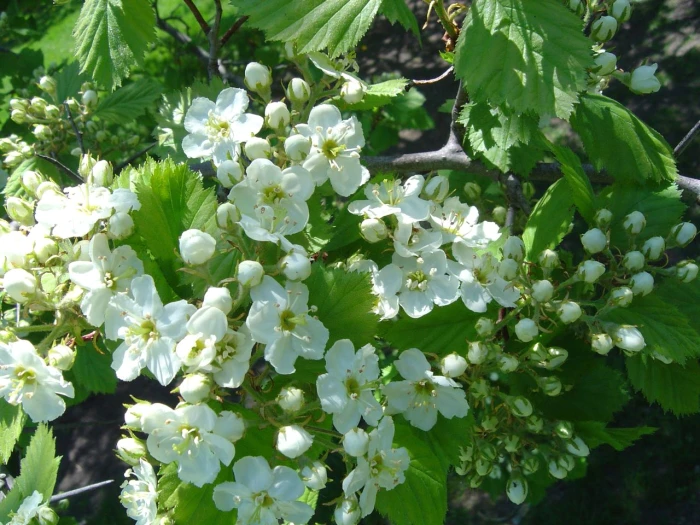Northern Downy Hawthorn
(Crataegus submollis)
Northern Downy Hawthorn (Crataegus submollis)
/
/

Nadiatalent
Public domain
Image By:
Nadiatalent
Recorded By:
Copyright:
Public domain
Copyright Notice:
Photo by: Nadiatalent | License Type: Public domain | License URL: https://creativecommons.org/public-domain/ | Uploader: Nadiatalent | Publisher: Wikimedia Commons | Title: Crataegus_submollis_flowers.jpg | Notes: Transferred from Flickr via #flickr2commons |




















































Estimated Native Range
Climate Requirements for Layton, Utah
| This Plant | Your Site | Plant Suitability for Your Location | ||
|---|---|---|---|---|
| • Precipitation | 17" - 63" | 20" | Your precipitation may be insufficient for this plant. Irrigate N" / year. | Irrigate N" / year |
| • High Temp. | 64°F - 89°F | 90°F | Your summers may be too hot for this plant. | Too hot |
| • Low Temp. | -6°F - 35°F | 20°F | Your winter temperatures are normal for this plant | Excellent |
This plant should grow well at your location with about N inches per year (Y minutes per month) of irrigation.
Summary
Crataegus submollis, commonly known as Northern Downy Hawthorn, is a deciduous tree or large shrub native to open woodlands and forest edges in the Northern USA and Southeastern Canada. It typically grows to a height of about 7 meters and has a rounded crown. The Northern Downy Hawthorn is notable for its clusters of fragrant flowers that bloom in late spring, ranging in color from white to pink, with a rare occurrence of purple. The flowers are followed by large, bright red fruits, or haws, which persist into winter and provide food for wildlife. The plant’s thorns, which can reach up to 7 cm in length, are a distinctive feature, offering protection to birds that nest within its branches.
This species is valued for its ornamental qualities, including its showy flowers and attractive fruit. It is used in urban and rural plantings, often as a specimen or in mixed shrub borders. The Northern Downy Hawthorn is adaptable to a range of soil types, from clay to loam, and prefers well-drained conditions. It is tolerant of both full sun and partial shade. While it can handle medium to high water availability, it is also somewhat drought-tolerant once established. Gardeners should be aware that this hawthorn can be susceptible to leaf blight and fire blight, and its thorns can make maintenance tasks challenging. It is not typically invasive when grown outside its native range, but care should be taken to prevent the spread of diseases to other susceptible plants.CC BY-SA 4.0
This species is valued for its ornamental qualities, including its showy flowers and attractive fruit. It is used in urban and rural plantings, often as a specimen or in mixed shrub borders. The Northern Downy Hawthorn is adaptable to a range of soil types, from clay to loam, and prefers well-drained conditions. It is tolerant of both full sun and partial shade. While it can handle medium to high water availability, it is also somewhat drought-tolerant once established. Gardeners should be aware that this hawthorn can be susceptible to leaf blight and fire blight, and its thorns can make maintenance tasks challenging. It is not typically invasive when grown outside its native range, but care should be taken to prevent the spread of diseases to other susceptible plants.CC BY-SA 4.0
Plant Description
- Plant Type: Tree, Shrub
- Height: 20-30 feet
- Width: 20-30 feet
- Growth Rate: Moderate
- Flower Color: White
- Flowering Season: Spring
- Leaf Retention: Deciduous
Growth Requirements
- Sun: Full Sun, Part Shade
- Water: Medium
- Drainage: Slow, Medium, Fast
Common Uses
Bee Garden, Bird Garden, Edible*Disclaimer: Easyscape's listed plant edibility is for informational use. Always verify the safety and proper identification of any plant before consumption., Hedges, Hummingbird Garden, Low Maintenance
Natural Habitat
native to open woodlands and forest edges in the Northern USA and Southeastern Canada
Other Names
Common Names: Downy Hawthorn, Northern Red Haw, Quebec Hawthorn, Hairy Cockspurthorn, Quebec Hawthorn, Arnold’s Hawthorn, Canada Hawthorn, Champlain Hawthorn, Emerson’s Hawthorn, Pilgrim’s Whitethorn
Scientific Names: Crataegus submollis, Crataegus champlainensis, Crataegus mollis var. champlainensis
GBIF Accepted Name: Crataegus submollis Sarg.